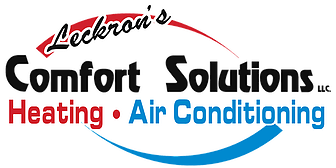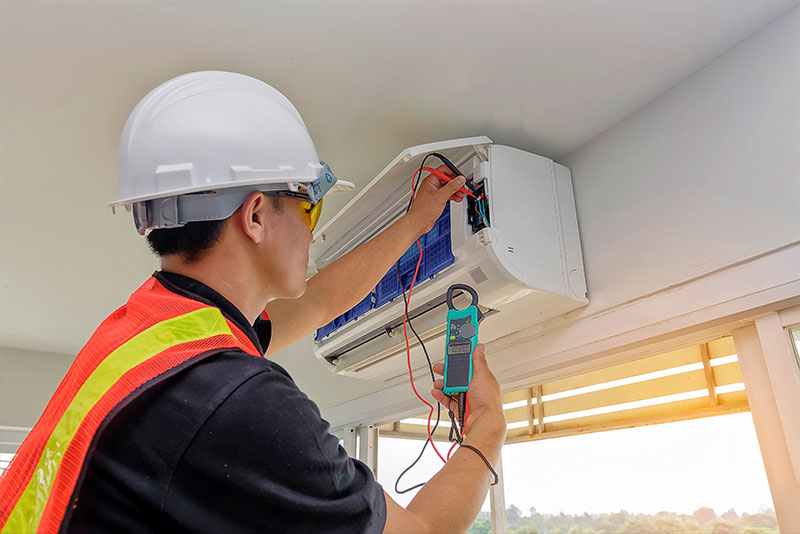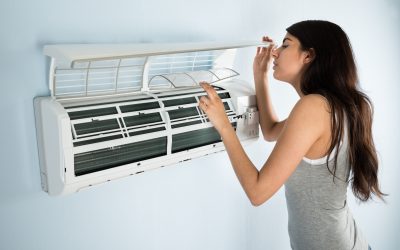HVAC – you’ve likely heard the term but may not know what it is or why it’s important. HVAC systems, or Heating, Ventilation, and Air Conditioning systems, are responsible for keeping the air comfortable and clean throughout your home.
Within this system, your furnace, heat pump, dehumidifier, air filters, and ductwork deliver clean air throughout your home. They remove dust, dirt, dander, mold, and other allergen while heating or cooling. An HVAC system can last 10-15 years with proper maintenance and upkeep.
Unfortunately, and like almost any other appliance, problems can arise… and generally unexpectedly. While many HVAC troubles are inconvenient and expensive, fortunately, some can be DIYd with a bit of know-how.
This article points out common HVAC problems, what is needed to address the problem, and when to call the professionals.
Common HVAC problems
There is certain HVAC repair work that, as a homeowner, you should refrain from attempting to diagnose or fix. Complex electrical components can malfunction and lead to damage, injury, or cancel your warranty. Furthermore, leaks can let off dangerous gas inside your home if you are not careful.
On the other hand, when something is a simple fix, there is no use calling in the big guns to tackle it. Let’s look at some of the most common HVAC problems homeowners encounter.
Dirty air filters
For something that seems so minor, dirty air filters can cause havoc on your system. For starters, when air cannot pass easily through your filter, your system has to work harder to push the air through. As a result, the HVAC system requires more energy, raising your electricity bill.
Even with the additional energy to push the air through, it will do so poorly. In turn, your air will be less clean, and the delivered temperature will be far from ideal. The extra effort to move the air leads to overheating and overworking your system.
Clogged condensate drain
A telltale sign you have a clogged condensate drain is standing water in the condensate pan under your unit. If you find this, you likely have a clogged drain line.
A clog can result from dirt, debris, sediment, mold, or sludge becoming logged in the drain line preventing drainage. Eventually, this water collection will shut the machine off or overflow into your home, causing damage from the water runoff.
Faulty thermostat
A faulty thermostat has numerous consequences. Short cycling, when the thermostat senses incorrect temperatures, causes the heater to shut off without completing the heating cycle. End result: wear and tear on the system.
Another thermostat issue is within the wiring. When wires lose connection or become damaged and frayed, the system will not run as designed. This causes the blower to stop running or the heater to turn on. Wasted energy and system breakdown are byproducts of faulty thermostat wiring.
Refrigerant leaks
Refrigerant levels in an AC system should remain the same. Unlike the misconception, refrigerant levels do not slowly deplete in a unit. If they are, that is indication there is a leak.
Some ways you can suspect a refrigerant leak are:
- Increased cooling bills
- Longer time to cool your home or vents not blowing cold air
- Higher humidity levels inside the home
- Ice crystals or frozen evaporator coil or refrigerant line
- Water on floor by unit
- Hissing sounds coming from the system
- Bubbles in the evaporator coil
Frozen evaporator coil
The evaporator coil is a part of the air conditioner. Essentially, this coil contains liquid refrigerant. When warm air passes on top of the coil, the heat from the air is pulled to the coils, and the refrigerant turns to gas. This heat exchange cools the air, which is then used to lower the home’s temperature.
A frozen evaporator coil indicates a handful of problems. First, when there is a lack of airflow, not enough heat is available for the coils to absorb, and the condensation can freeze. The same vein applies when the air is not hot enough. Since the coils are trying to pull the heat from the air, if the temperature is too low, it can cause the condensation to freeze.
As mentioned earlier, leaks in the refrigerant can cause frozen evaporator coils. The system is overworking to compensate for the low levels of freon and, therefore, can show by freezing the coils.
Dirty evaporator coils and clogged drain pipes can cause surplus condensation and improper heat exchange. This excess moisture or the inability to move the heat around properly leads to freezing.
Noisy unit
Ideally, your HVAC system runs in the background. It is a relatively silent component of your home, so something is wrong when you hear banging, clattering, rattling, and hissing.
- Squealing: bad belt or motor bearing
- Rattling or banging: fasteners on the metal cage need tightened, or the components of the motor or blower have come loose
- Clicking on the outside unit: capacitor (imagine it’s like the unit’s battery) about to die
- Humming from the outdoor unit: capacitor is no longer supplying power, and the outdoor unit is attempting to run
- Loud whistles or screaming: if the condenser unit is making this sound, it likely indicates a refrigerant leak or an internal pressure buildup
- Metal on Metal: if coming from the fan, indicates something may be obstructing the fan or an ice buildup
Tools and materials
While each fix requires its own set of tools, having these on hand can help be prepared for the unexpected HVAC problem:
- Air filters
- Screwdrivers
- Towels
- Shower snake
- Wet/dry vac
- Drain gun
- Needle nose pliers
- Clean, dry paintbrush
- Paper or Q-tip
- Compressed air
DIY fixes for common HVAC problems
Some HVAC problems must have a qualified, trained technician to fix. However, before you call a technician for every situation, you can do a few yourself. This list provides a guideline on the common HVAC problem and how to address them.
Dirty air filters
Changing an air filter is a relatively uncomplicated task you can complete yourself.
To change your filter, locate your air filter and ensure you have the proper size for the new filter. Then, depending on if your filter cover is hand-tightened or tightened with a screwdriver, open the filter cover.
Replace the filter, being mindful to place it in the proper direction for airflow. Replace the cover and tighten the screw.
Replace your air filter every 1-3 months, depending on your system’s recommendations.
Clogged condensate drain
First – check your drain pan and outside unit to estimate how bad a clog is. If water is standing in the pan or has spilled out, turn off your furnace and use a towel to soak the excess water.
Then, keeping your furnace turned off, locate where your condensate drain is outside of the home. Is there a simple clog that can be removed with a gloved hand?
If the clog is more extensive, you may need a drain snake or flexible brush to unclog the pipe. First, run the drain snake in the exterior of your home. Then move back to the indoor unit.
Find the access point for the drain line inside the house. It is generally a cap on a PVC pipe tee. When you remove the cap, you will access the interior drain line. Notice slug or debris. If there is a significant clog, you will see standing water here, also. Run the drain snake here, also.
If this does not do the trick, you must step up your approach. Use a wet/dry vac. Attach the hose over the end of the drain line and seal it so no air escapes. Then ensure the vacuum is set to suck and turn on to suck out the clog (versus blow).
If nothing comes out, this indicates the clog is not at the end of the middle of the line and is further back. A drain gun can shoot compressed gas into the clog to break it up, allowing it to be sucked out.
Check that the clog is removed by pouring water down the drain line. Finally, replace everything as it was, and then turn the furnace back on.
Faulty thermostat
Since thermostats involve wiring, you must eliminate your chances of electrocution. Turn off the power from your breaker box before messing with your thermostat.
Remove the cover of your thermostat. Usually, you need to grab the cover and pull it toward you. Some may require a screwdriver, but most are relatively easy to remove. Look for button clips or snaps that need manipulation to avoid breaking the cover.
Examine for wiring issues. Sometimes you see loose wires or those no longer attached that need reconnecting. Also, screws may need tightening. Needle nose pliers can help move and twist wires back into place.
Check for dust around the thermostat. Clear away any built-up dust with a clean, dry paintbrush. A Q-tip or sheet of paper can be used between tight spots. Blowing compressed air helps remove tight spots of dust.
Any thermostat wiring issues more than this, best to leave to the professionals.
Refrigerant leaks
If you suspect a refrigerant leak, you must call a professional immediately. Freon poisoning is a hazard caused by refrigerant leaking in your home. Be wary of a company that replaces the freon without finding and fixing the leak.
Frozen evaporator coil
The easiest and quickest step you can take in attempting to DIY a frozen evaporator coil is to change your air filter. This uncomplicated step can cause the air to flow easier and at appropriate levels through the home and over the evaporator coils.
Switch your AC to fan only. Allow several hours for air to pass over the coils, thawing ice from the coils. For heat pumps, run at defrost to thaw the coils.
If this does not solve the issue and the ice returns, it is time to call for more help. Do not attempt to scrape ice off a coil. It doesn’t solve the issue, and you risk damaging the coil.
Noisy unit
Homeowners can investigate some noises, whereas others must be left to the professionals. Here are some common noises your HVAC may make:
- Squealing: bad belt or motor bearing
- Rattling or Banging: if the fasteners on the metal cage have come loose, tighten them with a screwdriver. Call a professional if the rattling seems to be coming from the motor or blower.
- Clicking on the outside unit: if the capacitor is clicking, immediately shut off the unit. Keeping it on can cause further damage beyond repair. Call an HVAC professional right away.
- Humming from the outdoor unit: like clicking, turn off the unit and call your HVAC technician.
- Loud whistles or screaming: if the source of this is a refrigerant leak or pressure buildup, both can be dangerous. Turn off the system and call an HVAC company asap.
- Metal on Metal: turn off the unit asap. Visually inspect the unit – is anything causing the obstruction? Clean any debris. If the sound is still present, call a professional.
When to call a professional
Many homeowners only make an appointment if they cannot handle the problem themselves, and some problems can be fixed at home. For example, changing a filter is a straightforward HVAC maintenance task that can solve and prevent many issues. Same with keeping debris away from your indoor and outdoor unit.
Yet, certain tasks attempted on your own can set you up for an incredibly unsafe, if not lethal, situation. When it comes to your HVAC system, call for advice if you are unsure if you should attempt the repair.
Leckron’s will advise if this is a repair you can complete on your own or something better left to professionals.
Signs of an HVAC problem beyond a DIY-fix
- Electric Issues
When you see anything involving tripped circuit breakers, burnt out fuses, frayed wires, strange smells or noises, or if the unit is not producing heat or cooled air, these indicate a potential electrical issue.Attempting to repair an electrical issue could lead to electrocution or if done incorrectly, a major problem with the system. Leave these repairs to professionals to prevent a dangerous situation. - Compressor Problems
Odd sounds, frozen coils, air not adequately cooled or heated, or circuit breaker trips could all be compressor issues. Because the cause of these issues are vast, professionals know how to troubleshoot and properly fix the problem versus guess-and-checking. - Major Leaks: freon is a dangerous substance and not one you want to take on without proper training. Furthermore, if there is water after checking for clogs, there could be a break somewhere in the system. Professionals have the appropriate training to find the leak, ensure there is only one leak, and repair the issue without compromising your family’s health and safety.
Find an HVAC Company You Can Trust
Most of us are not trained in each HVAC system component, especially in diagnosing and repairing them safely. From asking a question to calling in an emergency, having a trusted HVAC company is imperative. Knowing you will be given sound advice, treated respectfully and fairly, and ensured the work is top-shelf is invaluable.
HVAC systems do not last indefinitely. Problems will arise. A regular maintenance plan prevents minor issues from morphing into full system repairs or an entire system replacement. As the saying goes, an ounce of prevention can replace a pound of cure.
At Leckron’s, we have both maintenance plans, as well as technicians ready to assist. We want your home not just to be comfortable but also safe. We will never recommend unnecessary work, as we aim to build a long, trusted relationship with each customer.
Anytime we have a HVAC need, we call Leckron’s and are always impressed with the quality of the services. Trustworthy, knowledgeable, and friendly. – Christy P., customer
Don’t wait until the problem means a full-system replacement. Let’s chat about what maintenance plan works for your home. If you are experiencing problems and unsure of your next step, we are here to listen and discuss the best options.
Leckron’s is here for your HVAC needs. Give us a call today.




